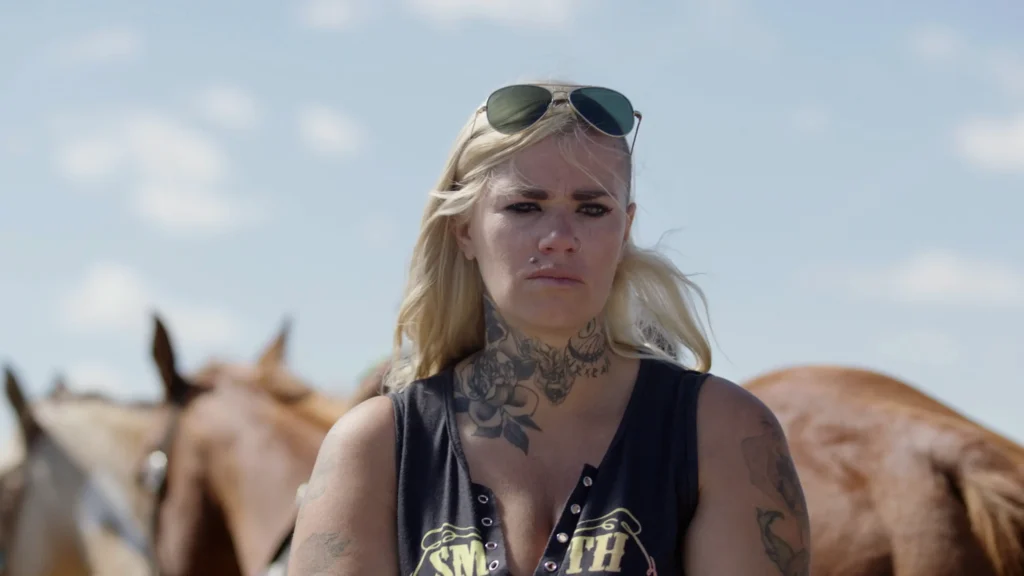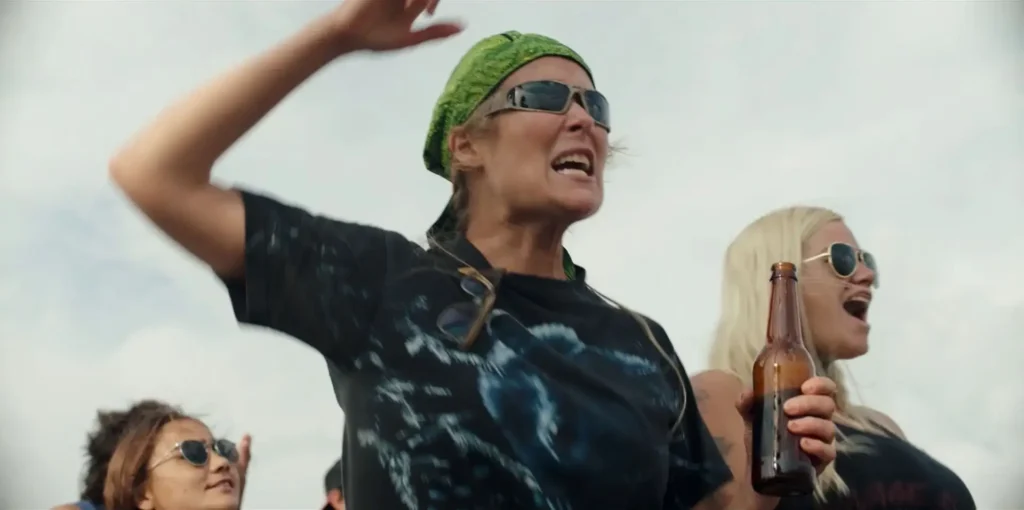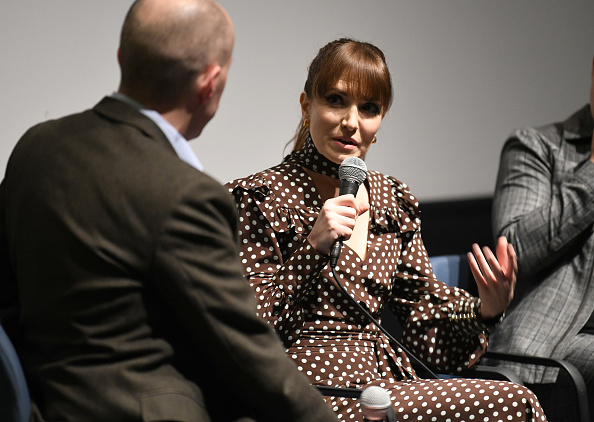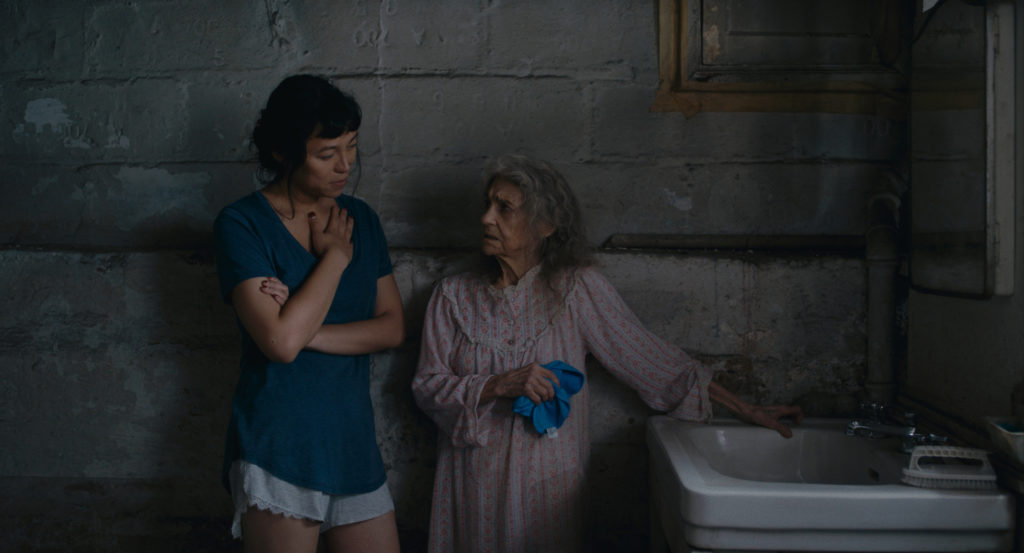“Want to see some real cowgirl shit?”
Those inviting words — from a South Dakota rancher to a Los Angeles-by-way-of-London filmmaker — were just the spark needed to ignite a film idea. EAST OF WALL was born from a fateful road trip to the Dakota Badlands, where actor-turned-director KATE BEECROFT discovered a compelling location, storyline, and an entire family of cast members for her feature directorial debut. East of Wall blends a real community, nonprofessional performers, and a few screen veterans to create a Western about matriarchy, nature, and resilience.
Beecroft’s docudrama centers on the real-life Zimiga family, led by rancher Tabatha Zimiga (playing a version of herself). With a house full of children, acres full of horses, and finances being stretched, Tabatha must decide what’s in her family’s best interest when she receives a tempting offer to sell her land. The cast, which includes Tabatha’s daughter Porshia Zimiga, is further fleshed out with the talents of two SAG Award-winning actors, Scoot McNairy and Jennifer Ehle.
East of Wall premiered at the 2025 Sundance Film Festival, winning the NEXT Audience Award (and where Kate also co-hosted Sundance’s SAGindie Filmmakers Luncheon). The film continued on a successful festival tour, including the Tribeca Film Festival, Bentonville Film Festival, and Nantucket Film Festival (where Beecroft won the Adrienne Shelley Excellence in Filmmaking Award).
Sony Pictures Classics will release East of Wall in theaters nationwide on August 15. We spoke with writer/director/producer Kate Beecroft about the film’s unusual path from a sightseeing trip to an award-winning film.
__
COLIN McCORMACK: Looking back at the genesis of this whole project, what led you initially to being in South Dakota in the first place, where you met Tabatha and her family?
KATE BEECROFT: This movie all happened by a chance encounter. I had no real résumé as a director. So, my cinematographer [Austin Shelton] and I were just driving across the U.S., trying to find stories, beautiful scenery, or interesting faces that I could put on a reel as a director. In no way was I thinking, I’m going to find this feature and spend the next five-and-a-half years with this film and three years living with a family on a ranch in South Dakota. Honestly, when I first found the story, I wasn’t even sure that I was in South Dakota. I thought I was in Nebraska. I was like, “The lights are amazing, so wherever we are, I want to stay.” We were living out of a truck on the side of the road for weeks. That’s how I found this story.
CM: How long into meeting Tabatha were you like, “This is it, this is a story, this is my subject”?
KB: When Tabby and I are asked that, we kind of look at each other like, “Was there ever a moment where I said, ‘We’re going to do a movie’?” And there wasn’t. It was all so natural. Also, I didn’t have the pressure of a big studio over my head. There was no pressure; no one saw us coming. All I knew was instinctively, I wanted to see these faces on screen, and I wanted to see their life on screen. I was almost like an audience member; I was a fan of theirs. That’s why I spent those three years living with them, because I wanted to develop their story and learn as much as I could about their lifestyle and teach them how to act.
CM: You were embedded with them like a documentary filmmaker would with their subject. Did you go back and forth on whether a full-on documentary would be the right project versus the script based on their life that it ended up being?
KB: No. A lot of people do ask me why I didn’t make this a documentary. They also ask why I didn’t cast big actors as these leads. Because Tabatha is a great character, and so is Porshia. I think documentary filmmaking is such a specific skill, and I am a director who loves actors. So for me, it was a no-brainer. I wasn’t going to do a doc. They are actors, Tabby and Porshia, because they’re able to tell a story. That’s how I looked at them, and that’s how I went into it. Here’s some undiscovered talent. We’re going to make a movie. And all the kids rose to the occasion, and they really embraced their artistry.
CM: Were you actively writing the screenplay while you were living with them, or was it more for research, and then you went away to write the script separately?
KB: I was not writing the script because I think the script that I would have written when I first met them would have been so different than the script that I wrote after three years of living with them. The script is moments that they’ve shared with me about the past, and also things that we’ve gone through together; things I’ve witnessed happen on their ranch, and conversations that they’ve had. That’s how I crafted the script. Then we have the character played by Scoot McNairy, Roy Waters, that’s the fictional thread that weaves through. I had all of this in my body for three years, and then I sat down and I wrote the script in a day. I completely blacked out and just downloaded everything onto paper [laughs]. I don’t remember writing the script because it was such a different process from regular scriptwriting.

CM: Giving a screenplay draft to someone to read is always a little bit daunting. I can’t imagine the pressure that you felt handing it to Tabatha and her family for the first time. What was that like?
KB: It was like giving Tabatha a hundred-page love letter. I still have her response when she read it; I screenshotted that, and I look at it from time to time. The fact that I did right by her was massive. Then, to be able to collaborate with her as well. I love working with actors, and I’m not a precious director who thinks I know everything. I like to give the actors a brain. “Does this sound bad coming out of your mouth? Cool, let’s change it.” “What do you see here for your character? Oh, that’s not how I envisioned it, but tell me why.” I was doing that with the first-time actors, and I was also doing that with Scoot and Jennifer, the vets. It was such a collaborative process, and I think it’s because I came from an acting background, and the amount of times I wished a director had asked me what my opinion was. I would have really valued that, so I directed them in the way that I wish I had been directed.
CM: Were there tools or acting lessons that you pulled from drama school that you brought to the newer actors?
KB: You know, not really. Drama school makes you — especially since I went to drama school in London — basically become a blank slate for anyone to shape you into any character. You just have to be a blank person, which is so crazy looking back on that. Maybe that’s why some acting teachers didn’t like me, because I was like, “I’m not going to be a robot for other people to throw paint on me.” I wanted to bring my own experiences to storytelling. And that’s what I did with [the first-time actors]. I didn’t want to put them through crazy acting lessons because I needed them to be who they are and not overthink it. I needed to keep that authenticity. If they got in their head, like, “Is my alignment right?” That would have been hard.
The thing I did take away from drama school that I gave them was to choose an animal. What animal would you be? And because they love animals and they’re around animals all the time, it was so fun. It was, “You have a week. Come back to me with your answer.” Somebody said, “I’m an owl because I observe.” Great! So, when I’d be directing them, I’d be like, “Brynn, you need to listen a little bit more. Be the owl, be the observer.” Things like that. And then I’d try to keep it as much fun as possible.
With Tabby, it was just really knowing everything that makes her tick as a human being. Where she is emotionally and how to bring that through her eyes. That was also such a gift, that I knew these people so intimately. So I could whisper something in her ear, or say, “Hey, Tabby, can you come into the next room with me?” And we could go over something emotional, and then she’ll bring that into the scene.
CM: I would think it takes a special actor — professional actor — to sign on to a project with so many unknowns. General unknowns, not just unknown co-stars.
KB: Or an unknown director.
CM: How did you go about finding Scoot and Jennifer for their roles?
KB: My producer, Lila Yacoub, worked with Jennifer on the film She Said. She’s so good in that. Jennifer and I also went to the same drama school in London. She was a stage actress, and that means that she knows how to work within an ensemble. That was really important to me. With Scoot, my mentor and EP is Scott Frank, and he had cast Scoot in Godless. I was reading him the cast list that our casting director for those two roles [Wittney Horton] put together, and he just said, “Stop. It’s Scoot. You don’t need to read me any more names. It’s Scoot McNairy.” I was like, “Okay!” That’s how it all went together.
When you’re casting professional actors in docu-fiction, it’s such a fine line. You have to be so delicate because you can’t have some big star who’s going to pop that docu-fiction bubble. It’s almost like theater, like you’re telling a story all together. You’re there for the story, you’re not there for the sexy Brad Pitt moment. You know what I mean? It’s storytelling. So, I wanted actors who just loved storytelling.

CM: Before filming began, did you think you would have to have different approaches for the non-professional actors versus the two pros? How did that differ or fall in line with your expectations once cameras were actually rolling on set?
KB: I was nervous. As much as I prepared my South Dakota cast, they’re going to be acting opposite people that they recognize from their televisions. I was very, very nervous the first day Jennifer got on set and was acting. I shouldn’t have had any worries. These teenagers and Tabby, they’re so fearless. It just upped their game. They came so prepared, and they were able to improvise; they were able to do anything. And I think Scoot and Jennifer were like, “Whoa, okay. I wasn’t expecting them to be that good.” They became incredible scene partners together. That’s why I love nonprofessional actors or first-time actors. The ego is not developed there yet. They’re not thinking, “What’s my angle?” “How am I coming across?” What I love about Tabby and being able to work with her family is that they just want to tell their story.
CM: You were working with these crazy variables, where you have kids, you have animals, you have nature, you have stunts. On a first-time feature. How did you wrangle all of those potential chaos-makers?
KB: I remember Scoot said to me, “It’s very rare that there’s a first-time director who’s battling teenagers, babies, horses, dogs, stunts, drones, and live events.” A live rodeo. It was a lot of moving parts. I think you have to be a little delusional and just say, “I can do it!” Brit Marling is one of my favorite directors, and she said this quote: “I always hope to be an amateur.” And they asked why, and she said because “amo” means “for love”. You have to love something enough that you become delusional, you become, “Yes, I can do everything,” because you’re in love. That’s how I felt this whole time.
Looking back, I’m like, Kate, that was insane. That was actually insane. But I loved doing it. They kept me on my toes. Was it difficult? Yes. Was it heartbreaking at times? Yes. But in the heartbreak, that’s always where you find the magic. When things go wrong, don’t freak out. You’re going to be presented with something that’s far better than what you could have written or what you were hoping for.
CM: I assume it must have been really meaningful when you finally got the chance to see the finished film with Tabatha and her family. Could you talk about that? And have you gotten to screen it in South Dakota for the community yet?
KB: The [family’s] first time seeing the film was at Sundance. And I did that for a reason, because I didn’t want them to see it at home with dogs barking in the background and people coming in and out. The second the credits rolled, I wanted to have 600 people at Sundance clapping for them. Because what they did was incredibly brave, and I think it should be honored, and they should be shown that people connected with their story. Especially winning the Audience Award at Sundance, that goes to show people connect with these incredible women whom they may have never seen in their world before.
And on Tuesday, I fly to South Dakota and we do our South Dakota premiere. A lot of the South Dakotan cast and the crew haven’t seen the film yet. I’m really excited. And I’m nervous for them to see it, of course. But I think they’re going to like the results. It will be fun, no matter what.
__
Thanks to Kate for discussing EAST OF WALL with us. Learn more about the film at eastofwallfilm.com.
This interview has been edited for clarity.
If you’re an independent filmmaker or know of an independent film-related topic we should write about, email blogadmin@sagindie.org for consideration.





